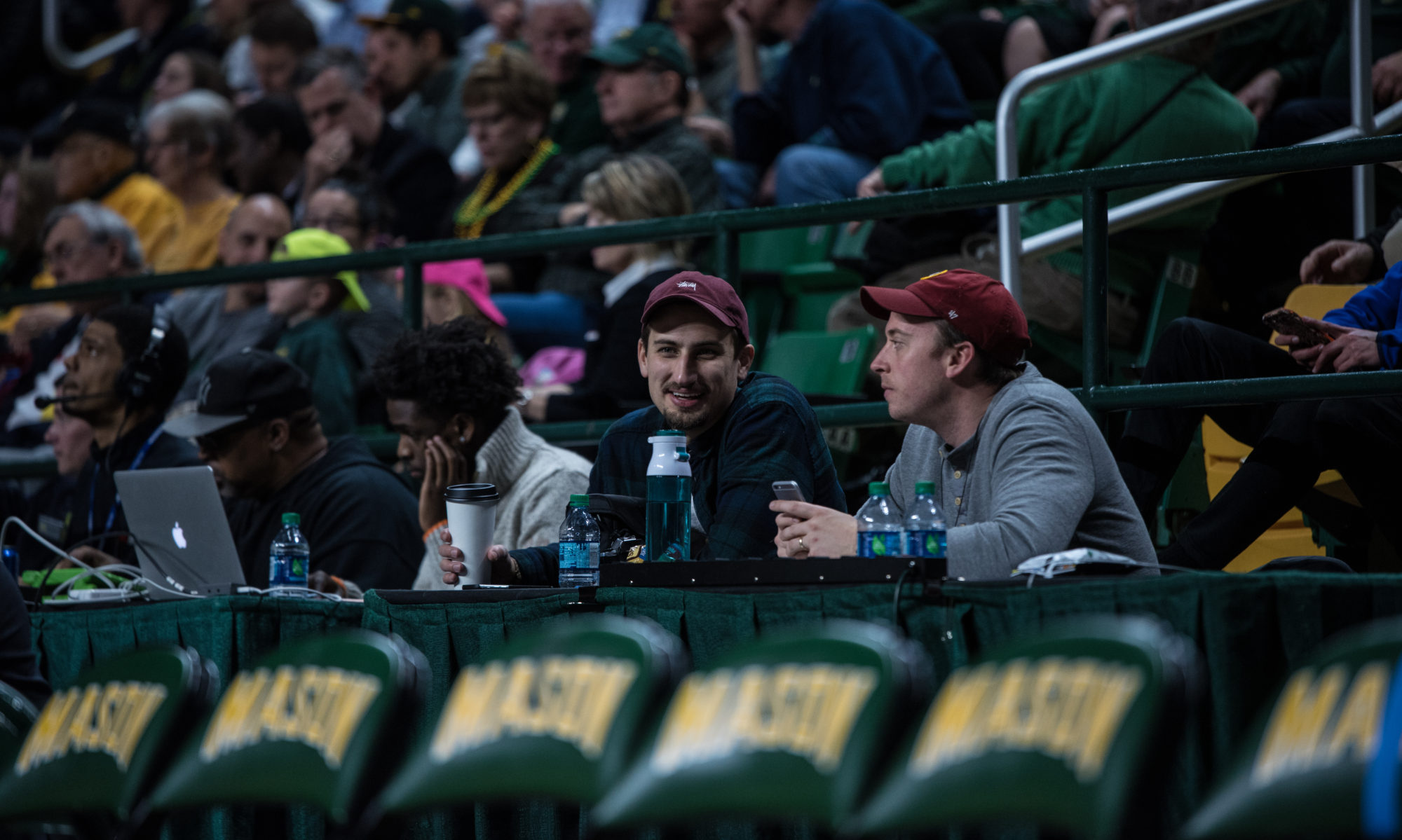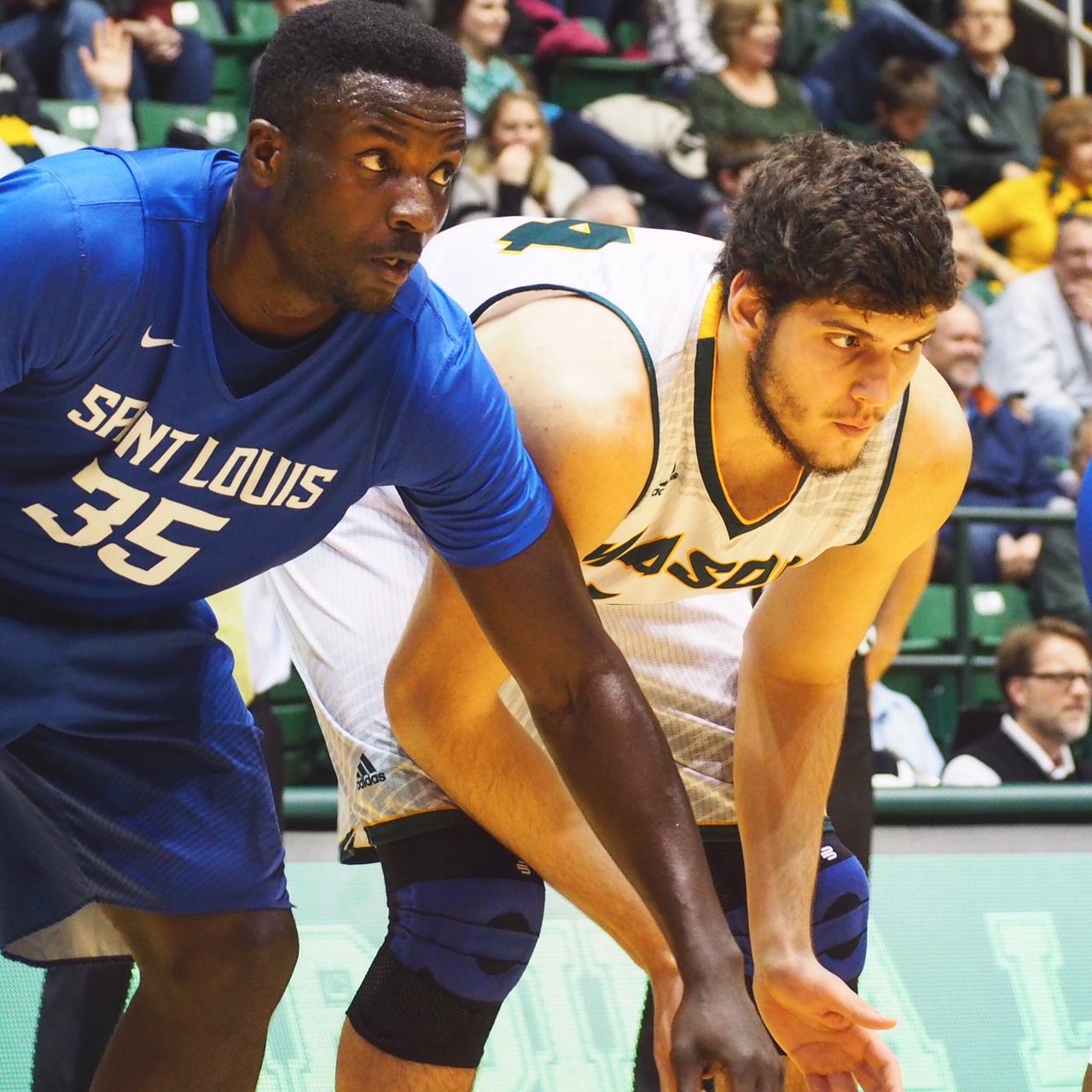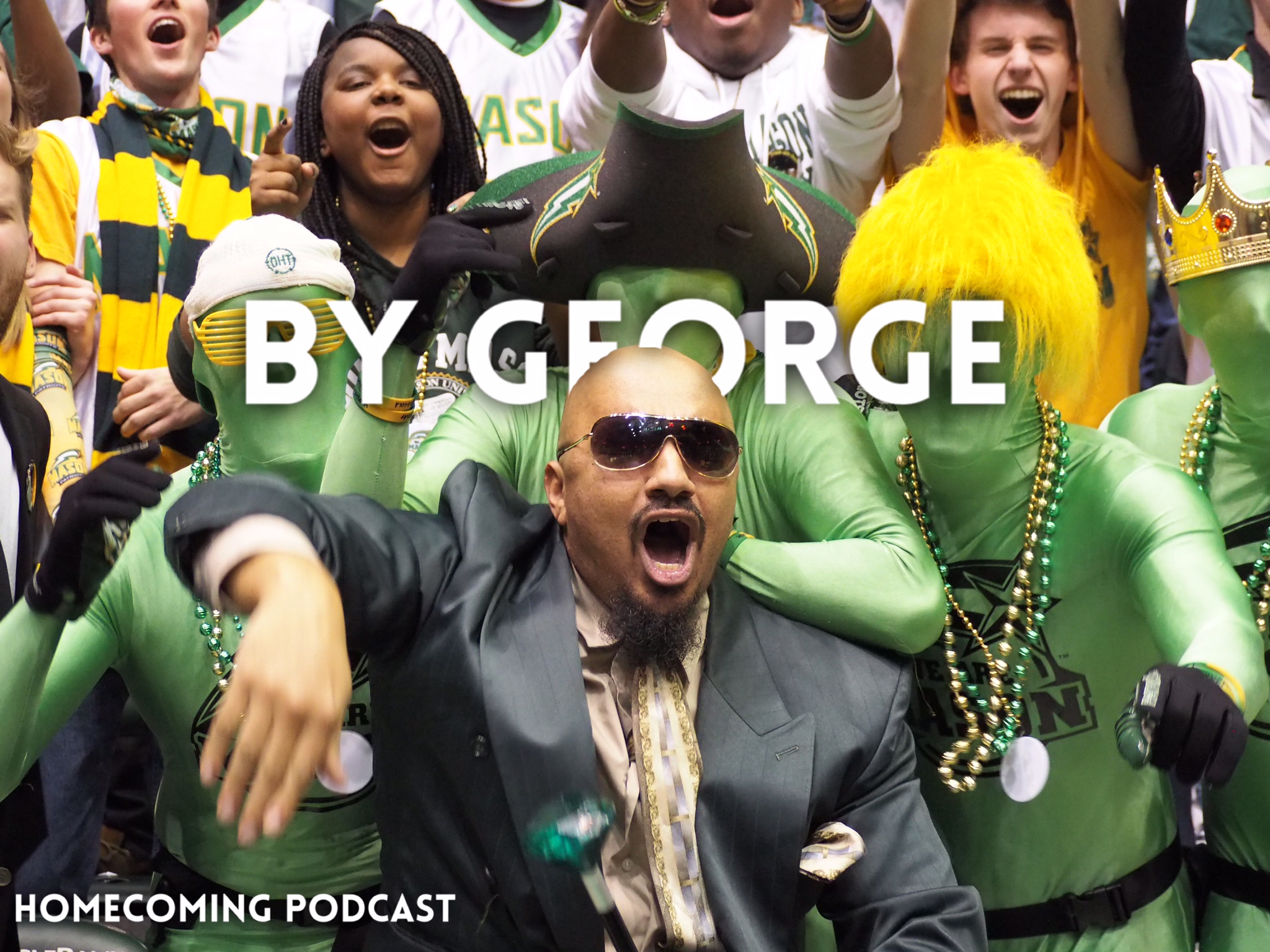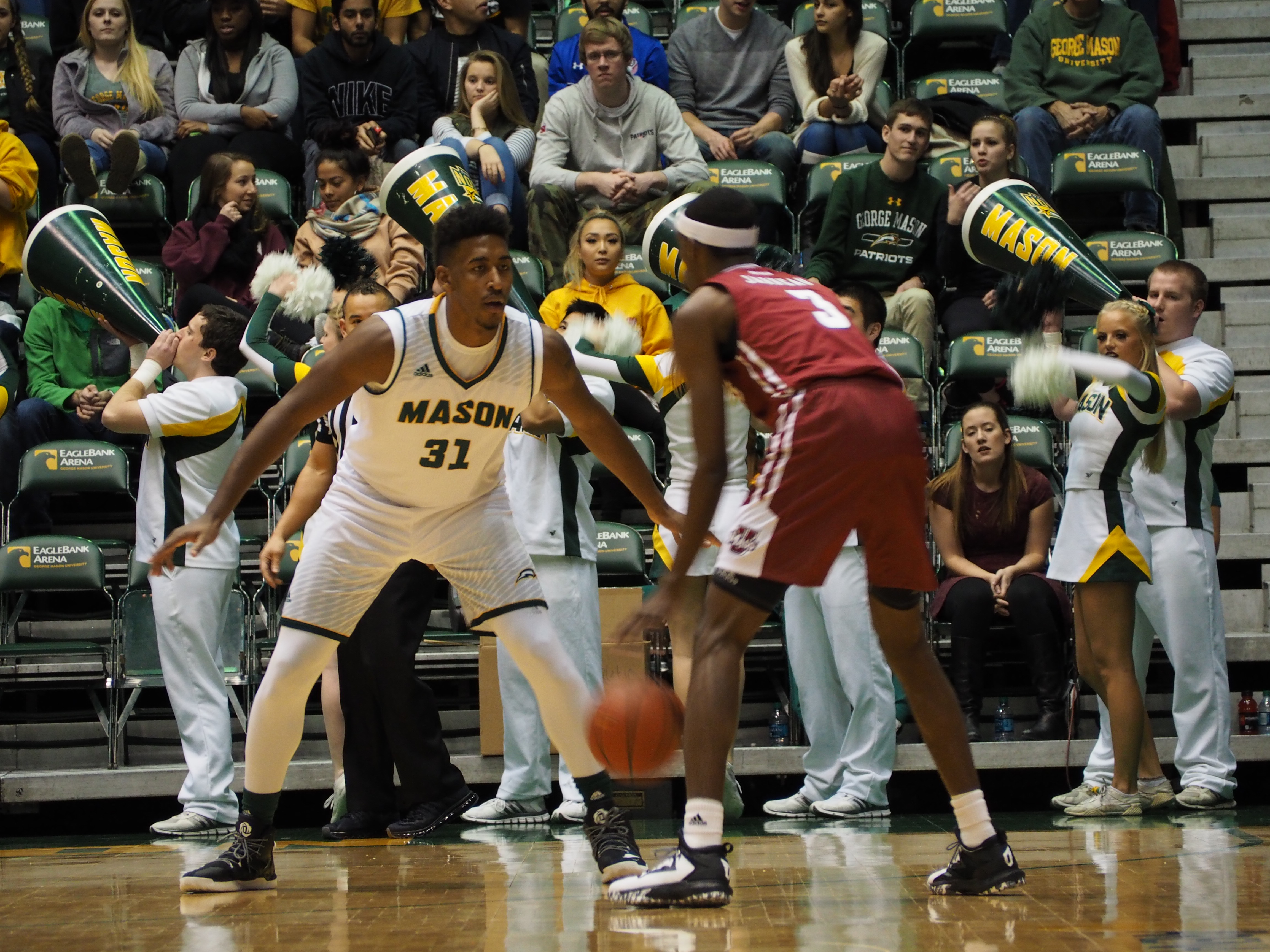Homecoming POPPED
Petey’s bucket of knowledge – the weekly breakdown
Hello Mason Nation! All the chalk talk this week is from the Davidson game. If I can find a recording of homecoming, that game might find its way onto next week’s breakdown. Let’s get to some stats and notes first.
- The bench scored 14 points combined in the St. Louis, La Salle, and Davidson games, in which Karmari Newman was suspended and Ian Boyd was suspended for two of the three. The starters scored 231 points in that stretch, or about 94% of our total scoring.
- The bench was good for 9 points between Karmari and Troy Temara against Fordham. This will hopefully get a little better now that Boyd’s suspension is over and we’re back to full strength, but the lack of bench production really lowers this team’s ceiling. We’ll need more productive and consistent bench contributions if we’re going to make a run in the A10 tournament.
- Consistent with the theme of the starters carrying a huge load, Otis Livingston and Jaire Grayer averaged 39 minutes per game in the four games between St. Louis and Fordham.
- Last week I asked if the three point defense was slipping. This week, we combined to allow 16-55 from deep, or 29.1%. Davidson and Fordham aren’t great three point shooting teams, but we still held both of them below their season averages.
- Mason gave up 5, 5, and 6 offensive rebounds against La Salle, Davidson, and Fordham, while corralling 28 offensive rebounds themselves in those three games. That’s a welcome trend, and one that might not hold up against the bigger teams in the A10, but it’s positive progress nonetheless.
- VCU shot 50% from the field against Mason to open A10 play. In the 11 games since, no team has shot better than 46.6%. Mason is holding opponents to 43.1% shooting in conference, which isn’t bad, but is only good for 8th in the A10.
- The schedule is about to get a whole lot harder. Richmond, Rhode Island, and Dayton are a combined 27-9 in conference. Mason then gets to go to George Washington, who proved a bad matchup in the first game, before getting A10 bottom-feeder Duquesne, before ending the season against 1st place VCU. A 1-5 ending to the conference season isn’t out of the question.
Chalk Talk
Davidson had an interesting strategy for defending Marquise, and it was effective. On most possessions one of their bigs was assigned to him, but when Marquise was off the ball, that big would stay in the paint to clog spacing. Teams have done that with Marquise’s defender before, but usually that means an extra guard playing rover, not a big. Davidson’s Peyton Aldridge and Will Magarity, 6’8” and 6’11” respectively, took turns guarding Marquise but playing well off him. In this clip you can see Aldridge is assigned to Marquise. Marquise gets the ball above the arc. Aldridge, planted in the paint, flashes out to guard him, but still doesn’t come out past the elbow. Marquise shoots and hits the three.

Here’s a play from the second half where Magarity (22) is assigned to Marquise. Magarity totally leaves him alone at the top of the key and doubles Jalen instead. Marquise spends most of this play with his defender at least 15 feet off him, and the double team causes Jalen to turn the ball over. Remember this because it will be important later.
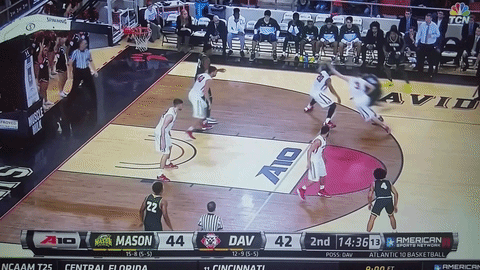
Before we get much further let’s check in on Temara and Relvao. Here, Temara hedges a ball screen set by Davidson’s Magarity. Jaire is supposed to check Magarity when he slips to the post. However, Jaire drifts off to guard Aldridge (a very good three point shooter), Kier is supposed to slide over but is late, and Temara doesn’t get back in time. The result is an easy dunk for Magarity and everyone looking at each other wondering what happened. It’s tough to assign blame here since our scheme leaves this sort of thing open if the rotations aren’t tight.
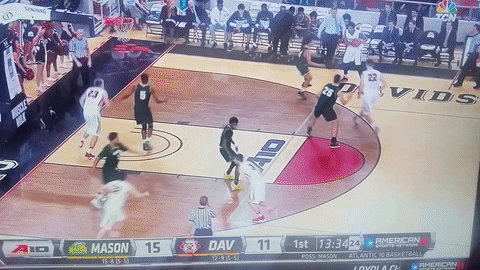
Relvao gave us some very solid minutes off the bench after Jalen got his second foul. This play is very similar to the one above, but it’s a little slower developing for Davidson, in part because Relvao forces Gibbs so high off the arc, and that allows Relvao to recover and block the shot. Relvao defending like this makes the minutes Jalen is on the bench a lot less scary.
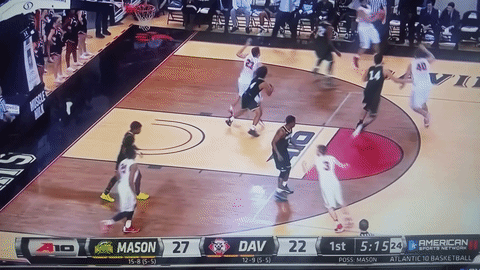
Here’s a play that shows how teams are starting to attack our very predictable defensive rotations. Magarity sets a ball screen for Gibbs. Relvao hedges, as is tradition. Otis leaves his man to check Magarity, who slips to the post. With Kam and Relvao occupied on Gibbs and Otis in the post, Pritchett (#20) gets a wide open three from the wing. Luckily, he clanks it.
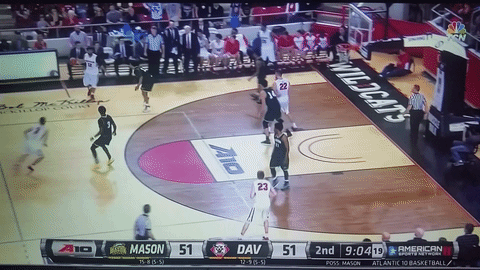
This is worth mentioning because it’s illustrative of how good teams can take advantage of our constant hedging on ball screens. Gibbs has two good options here – Magarity is a foot taller than Otis, who’s guarding him in the post, and Pritchett is about as open as he can be in a halfcourt set. This play works out in Mason’s favor, but there will be plenty more like it where it burns us.
Jalen was Mason’s best player in this game. We’ll get to the good Jalen stuff in a minute but first I feel obligated to mention a tendency of his that I’ve noticed. He anticipates ball screens and teams take advantage of him for it. Here, he steps away from the basket to hedge on Gibbs, anticipating a ball screen that never happens. Magarity zooms to the basket for an easy layup. The same thing happened on Mount St. Mary’s game-winning dunk earlier this season.
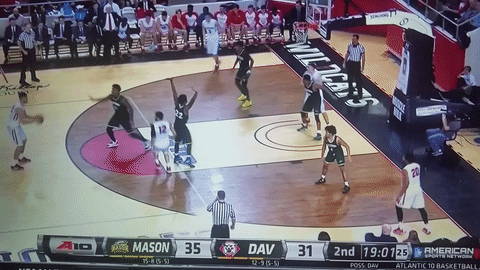
Alright, now we’ll get to the fun stuff. One of the smart things about Davidson guarding Marquise with a big was that it left Jack Gibbs to guard Otis. Otis struggled (5-14 shooting), which is no shame. Gibbs is a senior and a very good defender. That’s why I loved this play from Jaire and Otis. Jaire motions Otis over, gives him a quick pass, and sets a hard screen on Gibbs to create separation. Otis gets as much daylight as he’s seen all day and hits the long pullup two. This play looks like it might have been improvised, which makes it that much cooler:

Marquise and Jalen ran a really pretty low ball screen just before that. Jalen screens for Marquise, Jalen’s defender hedges, Jalen pins both of them above him, turns, and catches a great entry pass from Marquise. Caught out of position, Magarity commits the foul while giving up the basket.
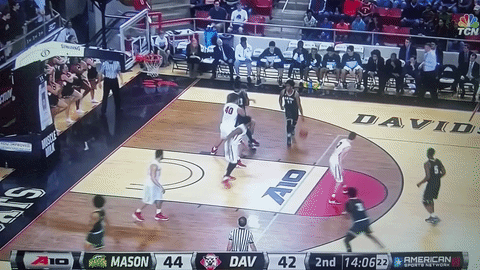
One play that kind of flew under the radar in this game was Jaire’s steal and layup that tied the game after Davidson went on a run to take a lead. The camera cut away during the steal so you can’t see it, but let me assure you that gigantic stones are required to pull this off:
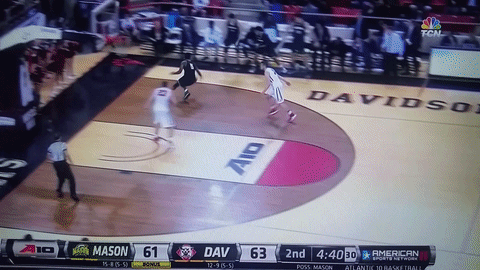
Jalen had 23 points on 13 shots, mostly because he would get isolated on the baseline, and Davidson didn’t have anyone who can cover him 1 on 1. Marquise’s defender was watching for cutters and would only slide over when Jalen got into the paint, at which point it was already too late on several occasions. I’m going to take a few gifs off from explaining and just let you guys enjoy Jalen taking Magarity and Aldridge to the torture chamber:

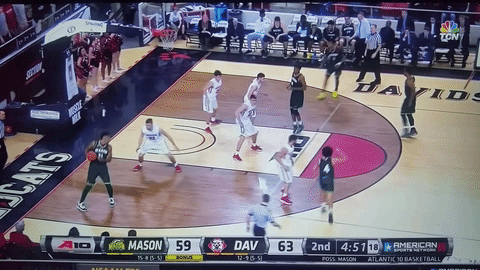
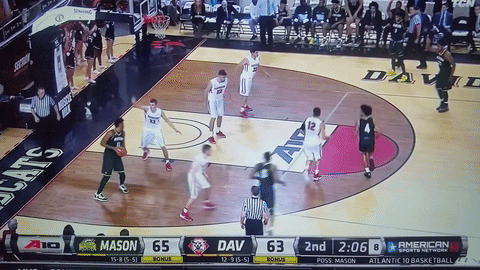
Finally, here’s where Mason really made Davidson pay for their strategy to defend Marquise. Up a bucket with just over a minute left, Davidson sticks to the game plan and doubles Jalen in the paint, taking the risk of leaving Marquise open. Jalen finds Marquise, no defenders try hard to contest, and Marquise drills a three. There’s your ballgame:
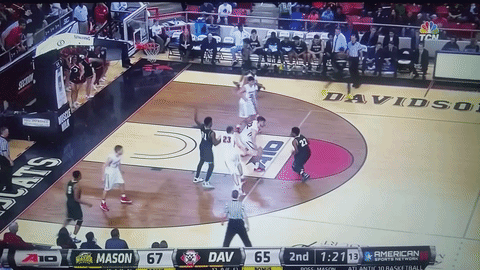
Davidson’s strategy largely worked. Marquise was 2 of 4 from three and 3 of 11 inside the arc, where he couldn’t find much space. Gibbs held Otis to 5-14 shooting. Mason needed Jenkins to be a monster in this game, and he came through. Along with Jaire’s quietly efficient 12 points on 7 shots, it was enough to get past a solid Davidson team on the road.
Until next week, Mason fans. Go Patriots!
A10 player of the year watch
Happy Friday! It’s time to check back in on the A10 Player of the Year race. To read my primer on these rankings, click here. If you’re not going to take the bait and give me a click, here’s what we’re trying to do:
– Rank A10 POY candidates in the order I currently have them, not to predict who wins what
– I heavily favor usage, workload, and efficiency
– I’m looking at conference only stats. Why? No reason. My rankings, my rules.
– I use PPFGA (points per field goal attempt) instead of TS% of eFG%. PPFGA answers the question you really want to ask, i.e. how many points does a guy score every time he uses a shot attempt?
– I’m not trying to be contrarian, but the numbers I’m using will sometimes yield different results than what some other people have. That’s a good thing! There’s a fair amount of groupthink among the name brand players.
Before we get to the rankings, I want to show you something:
Player A: 13.3 points, 2.9 rebounds, 4.8 assists, 1.5 steals, 0.1 blocks, 20.2 PER, 21.8% USG, 1.43 PPFGA
Player B: 13.7 points, 4.7 rebounds, 3.1 assists, 1.3 steals, 0.9 blocks, 18.9 PER, 26.7% USG, 1.27 PPFGA
Player C: 15.4 points, 5.1 rebounds, 1.5 assists, 1.3 steals, 1 block, 24.6 PER, 27.6% USG, 1.69 PPFGA
Player C clearly has the most well-rounded resume, right? More points and rebounds, similar combined steals and blocks to Player A, and his efficiency and usage numbers blow the other two out of the water. The only thing he doesn’t have is assists, but he more than makes up for that everywhere else.
In case you’ve tried to guess, I don’t think anyone is going to get this.
Player A: Scoochie Smith
Player B: Charles Cooke
Player C: Kendall fucking Pollard!
Pollard was my dark horse for A10 POY last week and I see no reason to come off that now. He’s such a dark horse that Dayton people don’t even talk about him as a player of the year candidate. You hear Cooke thrown around a lot, Scoochie thrown around a bit less, but I don’t think either of them has a resume that holds up to Pollard’s. He’s scoring more points on a larger workload, and he’s crazy efficient while doing it. He’s also just as valuable defensively, if not more so, than his teammates, and he’s got a better offensive rating and a better defensive rating. Stats aren’t the end all be all – one of the shortcomings of doing it my way is that it kind of hurts players on good teams who cut into each other’s production – but Scoochie and Charles don’t have great efficiency ratings, and Pollard is doing it all on both ends of the court.
Now, some Dayton fans may say this is crazy. I’ve watched a couple Dayton games and Pollard doesn’t really jump off the screen the same way Cooke does. But I’ve got a very scientific system where I plug these arbitrarily chosen statistics into a spreadsheet, sprinkle in a defensive evaluation that you can’t see, then use my brain to decide which resume looks better. As far as the Dayton guys go, that’s Pollard at the moment.
Let’s get to the rankings:
IN THE LEAD: Jaylen Adams, St. Bonaventure
19.2 points, 3.7 rebounds, 5.7 assists, 2.3 steals, 0.1 blocks
23.2 PER, 28.6% USG, 1.44 PPFGA
Jaylen Adams had a rough shooting game in the VCU debacle last week, but he made 14 of 15 free throws, which actually kept his production quite viable. His box score stats aren’t as impressive as some of the others on this list, but around these parts we take those 2.3 steals per game very seriously. Jaylen is part of a scheme that loves to jump passing lanes (teammate Matt Mobley is second amongst the contenders in steals), and he can act like more of a free safety when the man he’s defending moves to the weak side, which helps his steals total. But he’s also a very capable on-ball defender. He might not be the consensus favorite, but he’s leading here for now. He missed a chance to really solidify his claim here against VCU, so this ranking isn’t terribly confident.
JUUUUUST BEHIND: TJ Cline, Richmond
19.7 points, 9.1 rebounds, 6 assists, 1 steal, 0.2 blocks
27.5 PER, 28.9% USG, 1.46 PPFGA
Eye-popping numbers! He’s spinning the box score! How is he not in the lead?
TJ Cline cannot play a lick of defense. He gives the Spiders next to nothing for paint protection. He’s the consensus number one, because Player of the Year is an award for people who fill up the box score, but here he stays in second. I do think he’s the odds on favorite to win it, and if I were betting today, I’d bet on him – look at those numbers again – 2nd in points, 3rd in rebounds, and 1st in assists among people on the list. But if those numbers come back to the field a little bit, his rank at the two spot is tenuous.
GETTING WARMER: Marquise Moore, George Mason
17.4 points, 9.7 rebounds, 3.8 assists, 1.4 steals, 0.6 blocks
24.3 PER, 28.1% USG, 1.33 PPFGA
We have our first mover! Marquise is up to third this week, stealing this spot from Peyton Aldridge. Like Adams, Marquise is the primary creator and best on-ball defender on his team. He spent most of Mason’s game with Davidson matched up on Jack Gibbs and did an admirable job, holding Gibbs to 12 points on 5-12 shooting. Marquise’s lacking efficiency holds him back, as he does it all for a surprising Mason team – he’s a great defender, he’s the A10’s leading rebounder, and he’s carrying a tremendous workload for a team that has a short bench.
DARK HORSE: Kendall Pollard, Dayton
15.4 points, 5.1 rebounds, 1.5 assists, 1.3 steals, 1 block
24.6 PER, 27.6% USG, 1.69 PPFGA
As discussed above, Kendall Pollard is arguably the best player on the conference’s best team.
COMING BACK TO EARTH: Peyton Aldridge, Davidson
21.4 points, 8.5 rebounds, 2.3 assists, 1.3 steals, 0.8 blocks
27.1 PER, 25.9% USG, 1.44 PPFGA
Aldridge is still right in the thick of this thing, but he decreased slightly since last week in every single number I’m listing here. He’s fighting an uphill battle because he’s not the highest usage guy on his own team (that would be Gibbs) but his numbers are impressive enough to keep him in this conversation.
STILL IN CONTENTION
Justin Tillman, VCU
15 points, 9.5 rebounds, 0.4 assists, 0.4 steals, 0.5 blocks
27.7 PER, 23.8% USG, 1.42 PPFGA
The VCU guys are all kind of cannibalizing each other. Tillman has the best resume from a top-2 team, and that counts for something.
Matt Mobley, St. Bonaventure
19.4 points, 5.4 rebounds, 2.4 assists, 1.6 steals, 0.4 blocks
21.1 PER, 24.4% USG, 1.44 PPFGA
Mobley is a very good player who had the game of his life against VCU, but he’s still second fiddle to Jaylen Adams, which makes it hard to put him too high here.
Jack Gibbs, Davidson
18.9 points, 3.8 rebounds, 4.8 assists, 1.4 steals, 0 blocks
20.9 PER, 28.5% USG, 1.25 PPFGA
SECOND OR THIRD TEAM CANDIDATES
Tyler Cavanaugh, George Washington
16.1 points, 8.2 rebounds, 1.5 assists, 0.5 steals, 0.3 blocks
22.5 PER, 29.6% USG, 1.31 PPFGA
Cavanaugh’s box score contributions are limited outside of points and rebounds, and he’s not very efficient. He’s basically 80% of Peyton Aldridge this season.
Charles Cooke, Dayton
13.7 points, 4.7 rebounds, 3.1 assists, 1.3 steals, 0.9 blocks
18.9 PER, 26.7% USG, 1.27 PPFGA
The Dayton guys are killing me. Cooke is a fan favorite, and it wouldn’t be a surprise to see him on the first team, but he’s been terribly inefficient, especially compared to the guys ahead of him.
Hassan Martin, Rhode Island
12.5 points, 5.2 rebounds, 1 assist, 0.6 steals, 2.2 blocks
24.7 PER, 25.1% USG, 1.39 PPFGA
Martin is something of a trendy first team pick. 2.2 blocks per game is great, but there’s nothing sexy about 12 points and 5 rebounds per game. He’s a very nice player, but the hype is a little overstated given his other contributions. Injuries have also limited him to only 23 minutes per game in conference.
EC Matthews, Rhode Island
15.5 points, 4 rebounds, 1.7 assists, 0.4 steals, 0.5 blocks
18.3 PER, 26.3% USG, 1.35 PPFGA
Like VCU, Rhode Island guys are cannibalizing each other. There’s not really a standout resume amongst them.
KEEP AN EYE ON:
Scoochie Smith, Dayton
Jordan Price, La Salle
ShawnDre’ Jones, Richmond
Check back next Friday for an update.
Freshmen Five – Ian Boyd
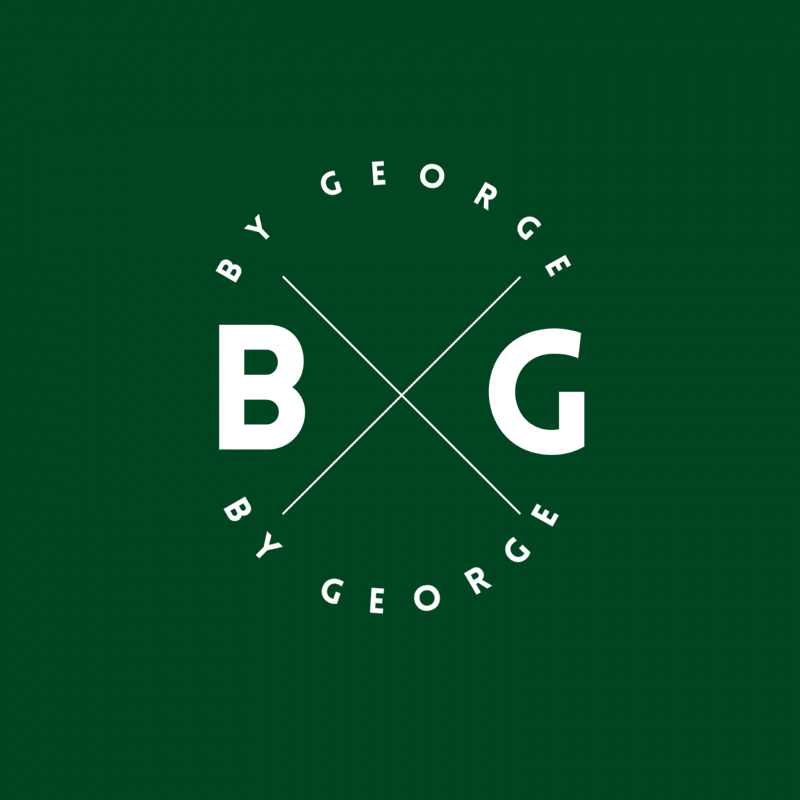
La Salle’s Ship Sailed, Davidson Ahead
Bryan wants to personally apoligize for popping his P’s this episode. #newmicnewproblems
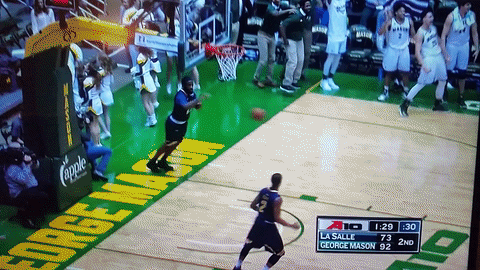
Petey’s bucket of knowledge – the weekly breakdown
Stats first today, then chalk talk afterward. Here we go!
Stats
Congratulations to my man Otis Livingston II for his A10 Player of the Week award. Here’s his combined stat line against St. Louis and La Salle:
48 points on 20 FGA (that’s crazy), 7 rebounds, 5 assists, 1 steal
Otis shot 8/10 from three combined in both games as well. He very nearly carried the team to victory in his career game against St. Louis – here’s a depressing split from the game:
Otis – 29 points on 15 shots
Rest of team – 45 points on 42 shots
Some other notes:
- Marquise, Otis, Jaire, and Jalen combined for 85 of the team’s 95 points against La Salle. We can’t count on that every night, which is why I’m very worried about missing Karmari for one more game and Boyd for two. The contributions from the bench are already slim, and we’re already riding our starters for heavy minutes. Otis and Jaire played over 80 minutes apiece in the past two games and Jalen played 75. Being short-handed against two very beatable teams in Davidson and Fordham is not ideal.
- Mason combined for five total steals this week. Dave’s defense doesn’t try to force turnovers (never has, even at Bucknell) but this is extreme. St Louis only turned the ball over nine times, and they were a bottom-50 team in turning the ball over before entering the Mason game. La Salle also turned the ball over nine times, but they’re much better at protecting the ball.
- Mason shot 10/18 from behind the arc and 21/31 inside it against La Salle. That 63.3% shooting performance is the best of the season by a country mile – we shot 52.2% against Lebanon Valley, and if you want to throw that out because they’re a D3 school, we shot 51.8% against Penn. The La Salle game was fun, but it’s well outside of what we should expect each game.
- Since recording a season low 5 assists against George Washington, Mason responded with 17 assists, 16 assists, and 15 assists in the three games since.
- Mason is shooting 26/51 (51%) from three in the last three games.
- Is the perimeter defense slipping? Mason allowed opponents to hit just 39/124 (29.1%) through the first six games of conference play. In the last four games, that number has ballooned to 40/101 (39.6%). Mason has faced two of the better three-point shooting teams in conference in George Washington and La Salle, but this is still something to keep an eye on.
Chalk Talk
All chalk talk today is from the La Salle game. I ain’t here to talk about Saint Louis. La Salle was a lot of fun, but we should keep things in perspective. They were even more short-handed than we were, missing BJ Johnson and Pookie Powell, two 30 minute per game players. But winning is still fun so we’re going to celebrate anyway.
La Salle’s threes to start the game were the kind of shots that our scheme encourages opponents to take. They came when we doubled the post and the post kicks out to the man who’s now open. The rotations were a little slow and they shouldn’t have been as open as they were, but that’ll happen. The rotations got tighter throughout the game and La Salle ended up taking a lot of contested threes in the second half. Here, Jaire leaves his man to double, Otis is slow to rotate, and Jaire is slow to recover, leading to an open three on the first play of the game. These ultimately aren’t a big deal, but they feel really bad when the opponent hits a few in a row like La Salle did:
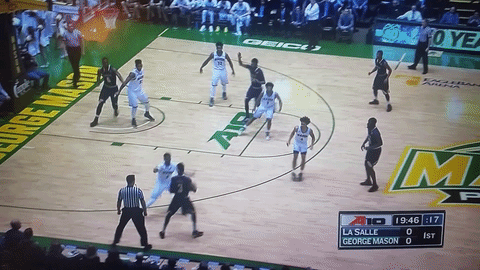
I’ve given Relvao some grief in this space so it’s time to give him some credit. He was a big part of the 15-0 first half run where Mason went from down 11 to up 4. Here are a couple nice plays of his. First, he catches a nice entry pass from Kam and does a nice job of spinning, ducking under the weakside help, and laying in the bunny. This is an easy play, since his defender leaves him for some reason, but earlier in the season this was the sort of play he wasn’t converting, so this is progress:
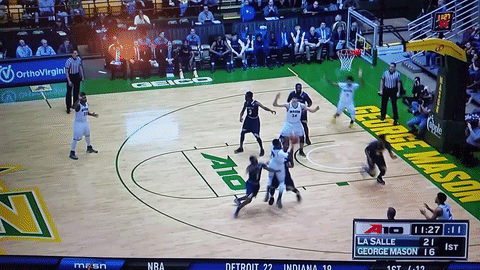
Next, he leaves his man to block a shot in the paint that starts a fast break for Marquise. He actually runs the floor very well and is in position for a tip-in that’s not necessary because Marquise finishes:
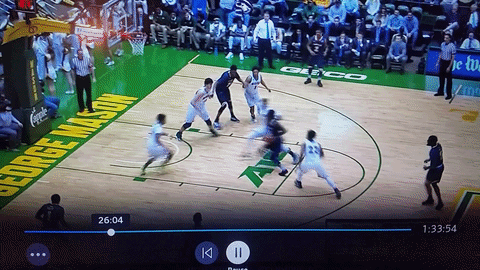
I think that for freshman bigs, it’s more important to pay attention to what sort of potential they flash than dwelling on what they don’t do well. Relvao and Temara both have a long way to go, but they’ve shown flashes of potential on both ends of the court. Writing them off at this point would be a mistake.
Let’s take a moment to pay homage to Justin Kier, king of the back cut. This first one comes against a 3-2 zone from La Salle, and the fun thing about this one is that it looks like improvisation. Justin sees Phiri (13) take a step toward Jalen and boom, he attacks the space in the zone and gets to the rim for the and-one:
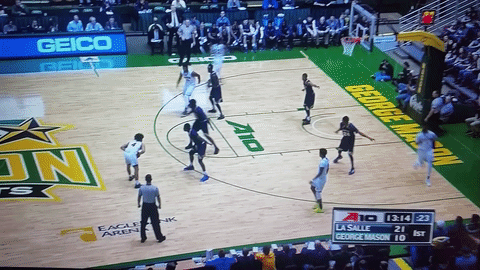
Here’s a beauty in the second half. La Salle’s defense gets stretched out when they try to trap Jaire on the baseline. Kier realizes no one is marking him and cuts hard to the basket again:
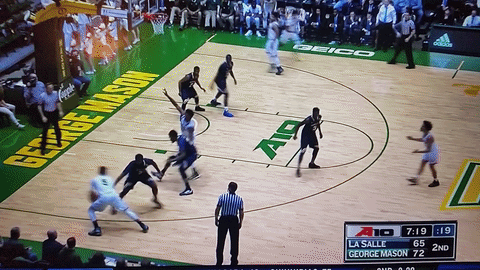
Otis had an absurdly efficient 19 points on 5/5 shooting. Nights like that don’t happen often. In this clip, Jalen sets a good screen, and Otis uses the space to hit a step-back, shades of Tony Skinn:
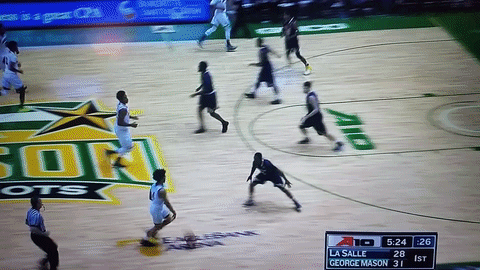
This was a great game for bench reactions. We’ll get to some more in a moment, but right now watch A) Kam break the ankles of Phiri, and B) Troy’s reaction on the bench, pointing to the spot where Phiri’s soul left his body:

You don’t need me to tell you La Salle’s defense was atrocious all night, but here’s one of the more fun examples of a total team brainfart. Shot goes up and no one boxes out the weak side:
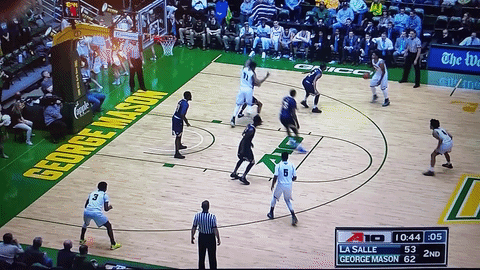
Alright, now we’ll get to Marquise’s career-high 28 points. Short-handed La Salle didn’t have anyone who could hope to stay with him. Here’s a simple rub play he runs with Jalen to get himself in the post against a smaller defender. Gonna miss these two next year:
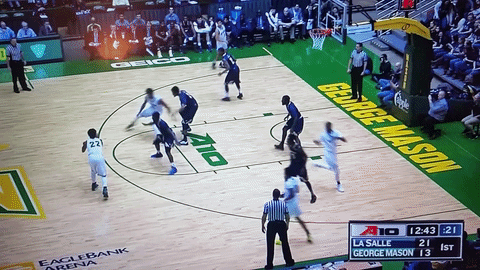
Marquise is so lethal because you can’t keep him out of the paint by single-covering him. If you send help, here’s what happens when your whole defense bends to keep Marquise from getting to the rim. Jaire has time for a nap between catching the pass and shooting:
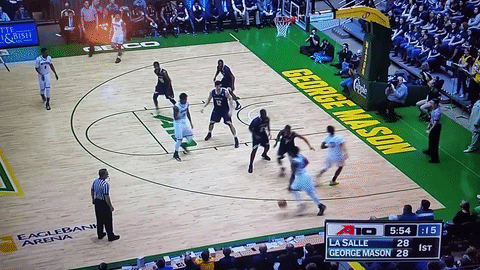
This is also a good example of why Jaire getting hot from three is so important – the offense looks U-G-L-Y when teams collapse on Marquise in the paint and the shooters can’t hit the kickouts.
Here, the help is weak and Marquise is too fast. He hits a scoop shot and the bench goes nuts:
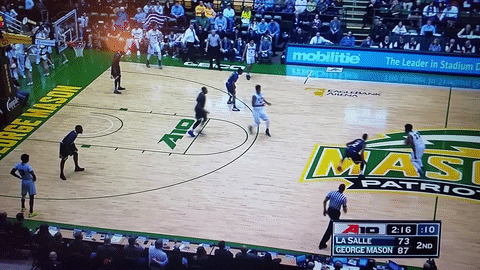
Marquise hits a three, one of three on the night. Look to the bench at Karmari’s disbelief as the ball is in the air. He can’t believe this shit:

And I love Marquise to death. Putting your guns in the holster after hitting three of your eleven career threes in the same game is laugh-out-loud funny:
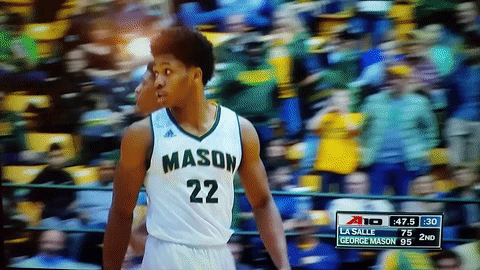
One last tribute to Mason’s bench mob. There’s so much going on here:

Until next week, Mason fans. Go Patriots!
Freshman Five – Justin Kier
A10 Player of the Year watch
Welcome! We’re going to keep tabs on the A10 Player of the Year race every Friday here through the rest of the season. Per usual, this entry will have a bunch of numbers and random stuff. A couple other things you should know:
- I’m looking at conference play numbers only.
- The criteria for rankings is mostly in my head, but I’ll heavily favor a combination of efficiency, workload, and defensive production.
- I’ve got some stat quirks. I like points per field goal attempt (PPFGA) better than true shooting % or effective field goal %. It’s much easier to understand and cuts right to the heart of the matter – how many points does the guy produce every time he uses a shot attempt? You can argue this is more important than any other measure of shooting. I’ll mention other shooting percentages if they’re interesting or illustrative, but PPFGA is a great way to roll everything you want to know into one number.
- The purpose here isn’t to monitor who I think will win. It’s to monitor who I think should If it looks different than consensus, that’s good!
As usual, thanks to college basketball reference for the data. Here we go. Remember, numbers and analysis based off conference games only:
IN THE LEAD: Jaylen Adams, St. Bonaventure
18.9 points, 3.7 rebounds, 5.6 assists, 2.4 steals, 0 blocks
23.7 PER, 28% USG, 1.49 PPFGA
Jaylen Adams checks a lot of traditional player of the year boxes – he’s the best two-way player on a good team, he’s a point guard who’s getting NBA looks, and he’s a very legitimate defender. He’s only shooting 41.2% from the field in conference, but he’s getting to the line almost 8 times per game and hitting about 75%, which greatly boosts his PPFGA number. He actually takes more threes per game (7.1) than shots inside the arc (5.6), which makes his ability to get to the line even more impressive. For as well as he’s playing on offense, it’s his contributions on defense that have him at the top of the rankings. His 2.4 steals per game lead the rest of the POY candidate field by a wide margin.
NIPPING AT HIS HEELS: TJ Cline, Richmond
19.1 points, 8.7 rebounds, 6.3 assists, 1.1 steals, 0.2 blocks per game
26.2 PER, 29.2% USG, 1.39 PPFGA
TJ Cline is a fantastically skilled offensive player, and the numbers he’s putting up are huge. As a point of reference, Deandre Bembry won A10 POY last year with 17.5 points, 7.8 rebounds, 4.7 assists, and 1.3 steals per game, and a PER of 22.6. Now, these numbers are boosted by Cline’s massive triple-double outing against Duquesne, so it’s likely that he comes back to earth a little bit. But Player of the Year is an award for stat accumulators, and no one in the conversation is filling up the box score like Cline right now. His efficiency numbers are also excellent, which shows he’s not just piling up numbers on volume. He’s relegated to the second spot because he gives the Spiders next to nothing for paint protection – he’s a big traffic cone on defense, and his inability to block shots reflects that. Yes, I’m basing that off nothing but his block numbers and the one game I watched him play against Mason. My rankings, my rules.
ALSO NIPPING AT HIS HEELS: Peyton Aldridge, Davidson
22.7 points, 8.7 rebounds, 2.4 assists, 1.6 steals, 0.9 blocks
29.5 PER, 26% USG, 1.49 PPFGA
Aldridge over Gibbs might be a surprise but look at those numbers again. It’s weird to think that those numbers aren’t even top two, but that’s how good the A10 POY race is right now. Peyton has been absolutely bananas in conference, and he’s making big contributions on both ends of the floor. He’s also playing 38 minutes per game (highest of anyone on the list) and hitting an insane 46% from three on 5.6 attempts per game. What’s holding him back is the fact that Gibbs has higher usage – it’s tough to call someone the A10 Player of the Year when they’re not the most prolific offensive player on their own team. However, his total box score and crazy high efficiency have more than earned him the third spot at this point.
STILL IN THE RACE: Marquise Moore, George Mason
16.3 points, 9.7 rebounds, 3.7 assists, 1.3 steals, 0.7 blocks per game
22.1 PER, 28.1% USG, 1.29 PPFGA
Marquise Moore is one of the more intriguing stories in the country, and he might be one of the most unique college basketball players in decades. As a 6’2” guard, he’s 17th in the nation in rebounding. There are no other guards in the top 30. He doesn’t shoot threes – 1 for 3 in conference – due to a totally broken jump shot that has never been adequately explained. But his bread and butter is getting into the paint, and teams have trouble stopping him. Like Cline, he has a triple-double to his credit this season, but it was against Penn in the Palestra and thus doesn’t count for these rankings. Marquise is up here because of his defensive ability and the workload he’s shouldering for a Mason team that struggles to score when he goes to the bench. He’s slowed offensively in the last three games, which is reflected in his declining efficiency numbers. But if he strings a few big games together he could move up the rankings easily. His rebounding ability is more than cosmetic – Mason runs a small four-guard lineup and needs every one of those boards.
DARK HORSE: Kendall Pollard, Dayton
14.9 points, 5.4 rebounds, 1.6 assists, 1.3 steals, 1.2 blocks
23.6 PER, 27.6% USG, 1.6 PPFGA
Pollard’s numbers aren’t eye-popping but he’s been very efficient, and his 2.5 steals + blocks per game are no joke. Dayton is 15th in the country and first in the A10 in defensive rating, allowing 91.9 points per 100 possessions. Pollard’s contributions on that end need to be considered. He doesn’t have the raw box score contributions you expect to see in a player of the year winner, but he’s worked his way into the conversation.
NOT DEAD YET (not necessarily in order):
Jack Gibbs, Davidson
20.4 points, 3.8 rebounds, 4.8 assists, 1.2 steals, 0 blocks
22.9 PER, 28.8% USG, 1.3 PPFGA
Jack Gibbs is putting together another great season in a great career, but for the purposes of POY evaluation, he’s not contributing quite as much as the guys ahead of him.
Justin Tillman, VCU
15.1 points, 9.1 rebounds, 0.3 assists, 0.4 steals, 0.6 blocks
28 PER, 24.1% USG, 1.4 PPFGA
Tillman’s progress this year has been a pleasant surprise for VCU. His box score contributions are limited to points and rebounds, but he’s a player to watch.
Charles Cooke, Dayton
14 points, 4.4 rebounds, 3.1 assists, 1.7 steals, 0.9 blocks per game
18.1 PER, 28.5% USG, 1.27 PPFGA
Tyler Cavanaugh, George Washington
15.7 points, 7 rebounds, 1.8 assists, 0.3 steals, 0.3 blocks
19.8 PER, 29.1 USG%, 1.34 PPFGA
ON THE WATCH LIST:
Matt Mobley, St. Bonaventure
Hassan Martin, Rhode Island
Jordan Price, La Salle
Shawn’Dre Jones, Richmond
Check back next Friday for an update.
Practice Makes A Patriot
By: Bryan Lawrence
Energy, something Dave Paulsen does not lack. You’ve probably seen DP scream at a Referee, dance up and down the coaches box or kick the scorers table. Most applaud these actions. It’s refreshing to witness his enthusiasm. He applies this intensity to practice as well. I have only seen two practices so far but it’s clear that he demands attention. There is no reason to miss a rep and if a player is caught in la la land, they will get called out. For as much yelling as I’ve heard him do, he’s also showed a patient approach. He stays calm in teachable moments and explains what he wants done and why. Engagement, effort and improvement appear to be important within every practice. Practices are filled with individual competitions and managers can be seen keeping stats or point totals. This resonates with me as this is how I run my practices as well.
I have coached basketball for six years at West Potomac High School at all three levels and continue to help at the varsity level scouting upcoming opponents and coaching in offseason leagues. Due to this, I understand the integrity of practice and game planning and can’t discuss many things I see. Does this mean “Practice Makes A Patriot,” will be a vanilla read? Absolutely not, and I hope to provide you interesting insight. So far, Paulsen gets an A+ for practice performance. Him and his staff seem well prepared and their knowledge of their opposition is evident. My one gripe with our staff is, do we have a big man coach? I have not gotten a chance to really probe about this but from a quick glance, it doesn’t appear so. Does the frontcourt coach have to be a larger individual? Also no, but I will dive further into this going forward.
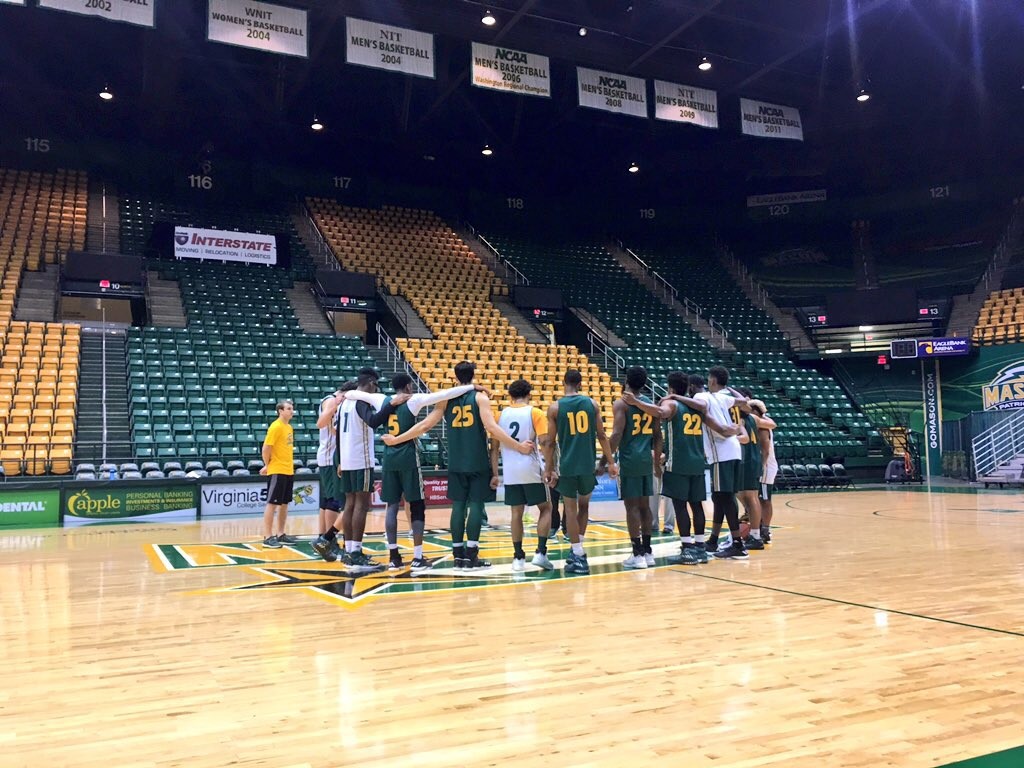
DP is not the only person who brings it at practice. It’s obvious that the team wants to get better, as a whole. They listen to their coach and they enjoy competing. Of course there are mental errors or occasional mishaps but it never really slows down the practice tempo. Jalen Jenkins is very vocal during 5 on 5 play. He critiques and makes suggestions as well as keeping it light with jokes. Everyone’s man, Otis, is a captain for a reason really maintaining the flow of practice. By his senior year, he will be able to coach most of practice himself. If Marquese Moore shouts at a player in practice, they know they either did something super smooth or need to shape up.
Quibits – (Quick Bits)
- The team spends 15+ minutes before practice working on individual skillsets
- After practice, they have a free throw competition
- Jaire Grayer’s athleticism is on display at practice and I believe we will see more of it in games as he grows into his body and skills.
- I’m intrigued to see Ian Boyd’s role after this season based on his abilities and our need to fill MM’s shoes
- Kameron Murrell can shoot the 3 ball
- Justin Kier can facilitate and we may see more of this once MM leaves
- Karmari Newman is a tough defender and uses his arms to be as wide as possible
- David Relvao is a smart player and as soon as he can just play instead of think about playing, we may have a special piece
- Troy Temara is one weird dude and I believe he embraces it
- A.J. Wilson helps with the scout team some and participates in all of the drills. He is freakishly athletic and springs off the court. I can’t speak in detail on his shot but do believe he can make an immediate impact next year grabbing offensive rebounds and running in transition
- Slim Otis, Slim who? Slim Otis is confident getting to the basket in games because he is confident doing so in practice. Some say he attacks to a fault, but it well pay dividends his next two years
- Jenkins and Moore and even Tate look like and act like veterans at practice. Just another day in the lab
- Graduate Manager, Bryson Johnson, hands out buckets in 5 on 5 play
- DP has messages for his team pre and post practice. One of the practices he spoke of being good civil servants to their communities. To end another practice he said, “this is when teams separate,” referring to where they are located in the schedule and rankings.
As I continue to view practice, my “Quibits” will become more detailed and focused. Again, I have only seen two practices and simply don’t know enough to expand too much further yet.
I love the practice intensity. I love the attentiveness of the players. I love DP even if I don’t agree with all of his decisions. I love the opportunity to cover practices, bringing you a consistent backstage vantage point. What would you like to know more about? Comment below and help me grow into this role.
We will be dropping our Freshman Five interviews starting Friday morning. Make sure to subscribe to our podcast (ByGeorgeGMU) on your podcast app to auto download our show as soon as it airs. Thanks for reading and continue to lurk around for other featured posts! #PracticeMakesAPatriot
